Kullander and Essen’s Unscientific Behavior on Swedish Television
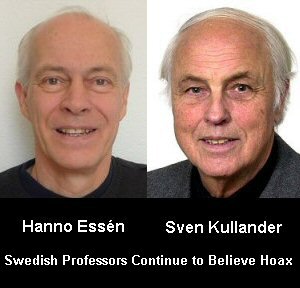
Dec. 27, 2012 – By Steven B. Krivit –
(Updated 11:20 a.m.)
Evidence for Rossi’s claim of extraordinary production of excess-heat from his E-Cat rested on the assumption that all water going through his device was vaporized into steam. This was not the case, as would have been revealed by rudimentary measurements of steam versus water output.
Two Swedish scientists, Hanno Essén and Sven Kullander, appearing on Swedish public television on Dec. 17 continued their endorsement of Andrea Rossi and his Energy Catalyzer. This New Energy Times article is in response to that program and presents a critical review of the behavior of these scientists and a review of the potential consequences of their actions.
Essén is a theoretical physicist and lecturer at the Swedish Royal Institute of Technology. He is the former chairman of the Swedish Skeptics Association. Kullander is a professor emeritus at Uppsala University and chairman of the Swedish National Academy of Sciences Energy Committee.
All evidence for Rossi’s extraordinary claim of kilowatts of excess heat from his E-Cat device hung on the qualitative as well as quantitative measurements of steam, had those measurements been made. By July 30, 2011, evidence collected by New Energy Times made clear that these measurements had not been performed and that the Rossi device was a hoax, if not a fraud.
In 2006, Essén had proposed a “cold fusion” theory but nobody paid attention to it. When Essén learned about Rossi’s device in 2011, he hoped that it would finally demonstrate experimental confirmation for his theory. Essén believed Rossi’s claim before he went to see the device and without seeing a published peer-reviewed scientific paper about Rossi’s claims. Essén bypassed customary scientific practice of proper skeptical evaluation of extraordinary claims and assumed that Rossi had performed competent measurements of excess heat and that he carefully reported all the technical features and experimental results of his E-Cat device honestly.
Neither of them performed even basic due diligence on Rossi and his past. Essén and Kullander had no idea that Rossi had a longstanding white-collar criminal history, including a conviction for fraud. They had no idea that, at one time, Rossi was a fugitive who went to the U.S. after he abandoned a hazardous waste dump in Italy which was the result of one of his earlier failed energy ventures. Had they known these pertinent facts, as scientists, they might have approached Rossi’s present technical claims with much greater caution, given his previous trail of apparent deception and misdeeds involving for-profit technology companies.
Before Kullander had seen Rossi’s device, and in the absence of both a published journal paper and an independent replication, Kullander went on record stating that the public must embrace Rossi’s claim. Kullander accepted as credible Rossi’s self-published paper on his blog. Rossi then invited Essén and Kullander, at Rossi’s expense, to travel to Italy to observe a demonstration of the Energy Catalyzer’s excess-heat production on March 29, 2011. Essén and Kullander ignored the fact that they did not see any production of large amounts of extremely hot steam.
The only diagram of the Rossi device available at the time was this one, from Giuseppe Levi, a physics professor at the University of Bologna:
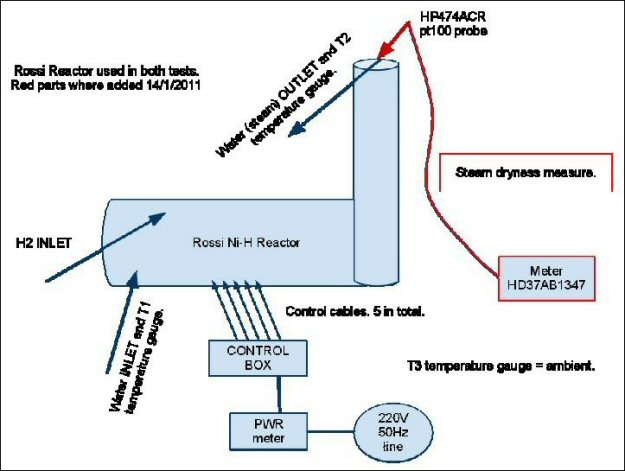
In the course of learning more about Rossi’s device, New Energy Times drafted the following schematic, which includes the all-important outlet on the right side for water or steam to exit.
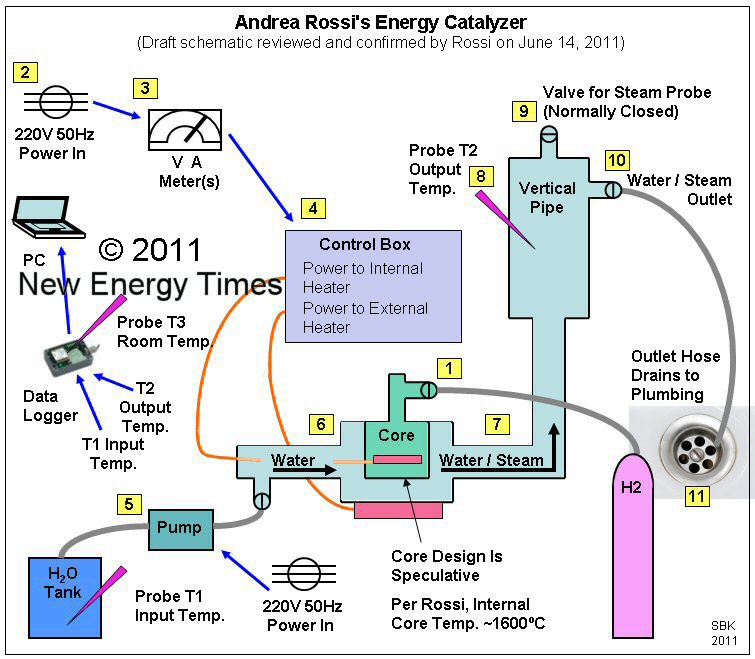
When they saw the device in Bologna, Essén and Kullander did not notice that Rossi was obscuring the liquid-phase water output from the device. They were not concerned about Rossi’s feeding the output through an opaque plastic tube down into a plumbing drain pipe through a hole in the wall where a sink used to exist.
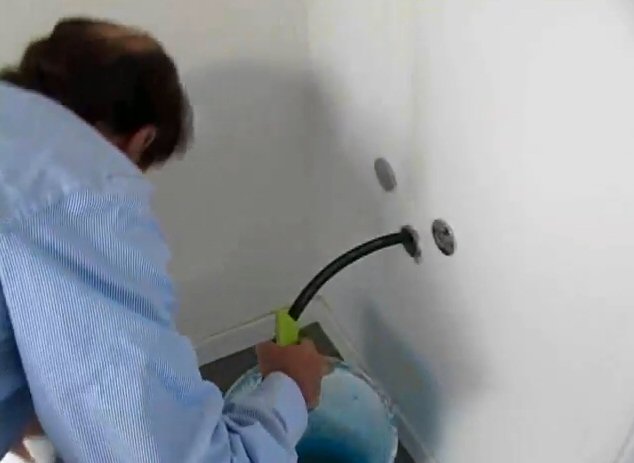
Rossi prepares to remove the hose from the drain hole in the wall to show the steam output during Krivit’s on-site visit in June 2011.
Without seeing a credible scientific paper or credible scientific data or performing an extensive long-term, independent test, Essén and Kullander convinced themselves that Rossi’s claim was real. On April 3, 2011, they published their trip report in a Swedish news magazine, Ny Teknik, and concluded, “Any chemical process for producing 25 kWh from any fuel in a 50 cm3 container can be ruled out. The only alternative explanation is that there is some kind of a nuclear process that gives rise to the measured energy production.”
Problem: A nuclear process was not “the only alternative explanation.”
Problem: Kullander and Essen didn’t check carefully to see that Rossi was not feeding unvaporized water down the hole.
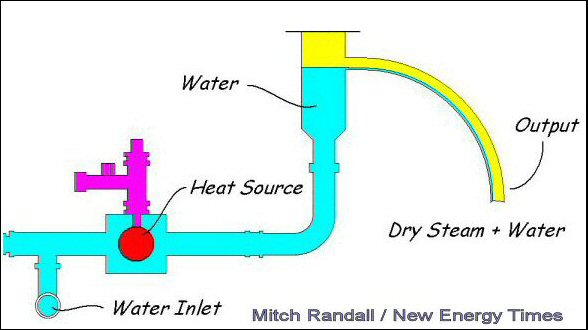
Fig. 2: Rossi’s E-Cat is designed to feed unvaporized water down the drain and thus deceive observers who fail to notice the lack of a high flux of steam output.
Problem: Kullander and Essén never saw kilowatts of steam, as claimed by Rossi, coming out of the device. They saw steam equivalent to that produced by an electric tea kettle, as we showed in our investigation “The Failure of Rossi’s Energy Catalyzer, Caught on Video.” Go to 11:25 in the video to see the amount of steam coming from Rossi’s device.
On June 23, 2011, New Energy Times sent an e-mail to Essén.
“Can you please go to 11 minutes 30 seconds on this video that I filmed last week in Bologna and tell me if the velocity of the steam you saw coming out of the valve, compared to the velocity visible at 11:30 in my video, was the same, slightly slower, slightly faster, much slower or much faster?”
Essén replied on July 5, 2011.
“The steam speed at least seems to be of the same order of magnitude,” Essén wrote.
On July 6, 2011, New Energy Times sent an e-mail to Essén.
Your report stated a 6.57-liter-per-hour input flow rate of liquid water. As you know, liquid water expands 1,600 times in volume when it vaporizes to steam.
Thus, if all the liquid was coming out as steam, you should have seen 10,512 liters-per-hour output flow rate of steam from the ~10mm (inner diameter) steam outlet valve. In your estimation, was the steam flow rate you observed from the valve on the Energy Catalyzer within a order of magnitude of 10,512-liters-per-hour?
Essén did not respond. On July 8, 2011, New Energy Times sent an e-mail to Essén.
In your April 3 report, you wrote, “At about 10:45, all the water is completely vaporized found by visual checks of the outlet tube and the valve letting out steam from the chimney.”
Q1. Can you please explain your “visual checks” to me in greater detail?
Q2. How do you know that liquid water was not flowing out of the chimney, through the opaque outlet hose, and then down the drain?
On July 8, 2011, New Energy Times reader Mitchell Randall sent an e-mail to Essén. Randall had already discussed this with Essén. Randall provided an April 19, 2011, e-mail that he had received from Essén in response to his question about how Essén confirmed that “all the water is completely vaporized found by visual checks.”
From: hanno
To: Mitch Randall
Sent: Tuesday, April 19, 2011, 3:34 a.m.
Subject: Re: Question regarding Rossi demonstration
We have had a large number of questions on the flow of water and amount of steam. Unfortunately, time and resources did not allow us to check these things more carefully.
The pump was set to pump at a certain rate and was not adjusted. Since there was no other path for the water than straight through the device in a single hose-pipe-hose track, we concluded that all the water must become steam. The steam was checked by observation and appeared to be consistent with the water flow, order-of-magnitude-wise.
I must also stress that our test must be seen in conjunction with the 18-hour test by Guiseppe Levi, which had better controls and had been set up with greater care and thought. Guiseppe Levi is an Italian physicist at the University of Bologna and is not associated with Andrea Rossi otherwise.
Later that day, New Energy Times telephoned Essén.
Krivit: Have you done any calculations on the velocity at which the steam should have been coming out?
Essén: No, but many people have done that. I have seen their calculations.
Krivit: Are you aware that many people have calculated that the exit speed should be 50 to 100 km/h?
Essén: Sounds like a lot. No, I wasn’t aware of that. There was not a huge water flow going in, so, intuitively, it was consistent with the amount of steam coming out.
Krivit: People who have made the speed calculations have written that the speed coming out of a 10mm hose of that length should be really fast; it should have sound and momentum. It doesn’t seem like you saw anything like that.
Essén: So where did it go then?
Krivit: Probably down the hose into the drain.
Essén: Down the drain? There was no drain.
Krivit: Where was the hose going when you saw it?
Essén: In the room next to the E-Cat, going into a hole in the wall.
…
Essén: But the reason I don’t find the steam stuff so interesting is that [Giuseppe Levi of the University of Bologna] did his experiment, although he has not written a good report about it, and there was no steam generation – just the heating of water – and it was all consistent with our findings, which makes the whole steam issue uninteresting to me.
Krivit: Do you have confidence in Levi’s sub-boiling experiment just on his word alone, or have you seen any data?
Essén: The data are few, but mainly, the report is oral.
Krivit: Are you aware that the measurement device they used to check the steam quality was the wrong device?
Essén: The wrong device in what sense?
Krivit: It was a device used to measure humidity in air. It was not designed for or capable of measuring vapor content of steam.
Essén: I have no comment on that, but it would be sad.
Essén: When you are boiling water in a vertical column, there is a phase-transition going on. If you are above 100 degrees, which I hope was correctly measured, then it is essentially pure steam.
Krivit: Except if you have a little extra pressure.
Essén: Yeah, OK.
Krivit: Did you consider –
Essén: The hose is fairly long, so some extra pressure, yes, maybe, it wasn’t measured.
Krivit: So the back-pressure from the hose was not measured, the steam flow was not measured quantitatively, the wrong device was used to measure steam quality. Are you still sure this is not a mistake?
Essén: I find that possibility very remote: a few percent wrong, maybe, but not by an order of magnitude. I am very sure about that.
New Energy Times sent a follow-up e-mail to Essén and sent him some of the technical analyses that we later published in Report #3.
Dear Prof. Essén,
It was good to speak with you just now. Enclosed are four analytical reports for your consideration.
The main issue is this: Observations of steam exiting the hose or through the exhaust vent at an inlet rate of 7 liters per hour should have been dramatic. The steam should have been coming out with great velocity, force, and noise. It wasn’t. Not for you, not for me.
Secondary issues:
– Rossi and Levi gave you the impression that they had properly measured the steam quality and that it was, indeed, high-quality [dry] steam. This [measurement was] not possible. They did not use a steam-quality measuring device.
– When I asked Levi to show me the data for his sub-boiling 18-hour experiment, he refused.
– No collection and measurement of water outflow or condensed steam outflow was made. This would have been simple to do and would have been convincing evidence.
– All outflow (with the exception of the steam through the exhaust vent for a short duration) was sent through an opaque hose into a drain; the qualitative characteristics of the outflow were hidden, and the quantitative characteristics of the outflow were unknown.
On July 15, 2011, New Energy Times telephoned Essén.
Krivit: What do you know about the calibration of the amount of steam coming out of Rossi’s device?
Essén: The steam amount was not measured. It was taken for granted that it all became steam.
Krivit: In either your experience or your efforts to inspect perpetual-motion claims, has anybody tried to claim anything on the basis of steam before?
Essén: No, I can’t recall that. I’m new at steam, unfortunately.
Krivit: Do you have any training in steam quality or steam enthalpy?
Essén: Just general thermodynamics.
Krivit: For example, like knowing the 1,600 times expansion rate?
Essén: I’d come across that before. I was aware of that.
[Note: Essén wrote nothing about the steam expansion rate in his and Kullander’s April 3, 2011, trip report.]
Krivit: When you pulled the hose out of the wall and saw the steam, did you think about the expansion rate?
Essén: No, I must admit I was thinking that I must check that the water is not draining out. I had this vague feeling that the water inlet flow wasn’t that fast, that the steam could be consistent with it, especially after some condensation in the hose. But we should have looked more into that, obviously, but there was not enough time. When we came, the setup was already there. To make any further studies, it was not possible.
Problem: When he observed Rossi’s device, Essén forgot that 1,600 liters of steam should have come out of the device for every liter of water that was going in. Therefore, at the time, Essen had no idea whether the amount of steam produced was consistent with the amount of water flowing into the device. Rossi claimed that he was feeding 7 liters of water into the device per hour. Essén did not think at the time that he should have seen 11,200 liters of steam per hour coming out of the device.
June 20, 2011 – Krivit Interviews Sven Kullander
Steven B. Krivit: When you looked at Andrea Rossi’s Energy Catalyzer, did you have the opportunity to see the output directly from the outlet on the E-Cat, or was the hose always attached to the outlet?
Sven Kullander: There is a valve on the top that was open, and we checked that the steam came out.
Krivit: Was the hose connected to the outlet at the same time you checked the steam?
Kullander: Yes.
[Note: With the hose attached, a direct pathway allowed unvaporized water to pass through the system without Kullander’s knowledge.]
Krivit: Do you know if the steam dryness was measured by volume or by mass?
Kullander: I think it was measured by volume, but I’m not sure.
Krivit: What makes you think it was measured by volume?
Kullander: Because I don’t see any mass involved; there is just volume quantities. It was a measuring gauge that was inserted inside. I could not see how that could be a mass measurement.
Krivit: If you don’t mind, can I ask who paid for your travel expenses?
Kullander: Rossi.
On July 30, 2011, New Energy Times published in our Report #3 that the question of whether the steam was measured by mass or by volume was irrelevant because the instrument the expert used was incapable of measuring steam; it was designed to measure humidity in air. Kullander failed to report this fact when he gave a public lecture (click here for his slides) at Orebro University on Nov. 23, 2011, and displayed percentages of non-vaporized water in an attempt to rebut critique in our Report #3. The data Kullander displayed in his slide #55 (below) were meaningless because the Testo device could not measure steam.
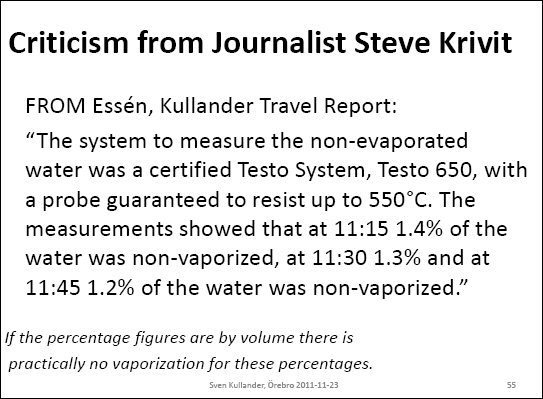
Slide 55 from Kullander’s lecture
On his slide #46, Kullander reproduced text from his and Essén’s report on the Rossi device:”All the water is completely vaporized, found by visual checks of the outlet tube and the valve letting out steam from the chimney.”
Problem: Essén told New Energy Times that, when he and Kullander were in Bologna, they pulled the hose out of the wall only one or two times for short periods of time to check whether all the water completely vaporized.
In his announcement for the talk, Kullander promoted Rossi’s device as real.
“Cold fusion has recently been developed in Bologna,” Kullander wrote, “and can be housed in an apparatus which is not much bigger than a coffee maker and generating energy only with a few teaspoons of nickel powder.”
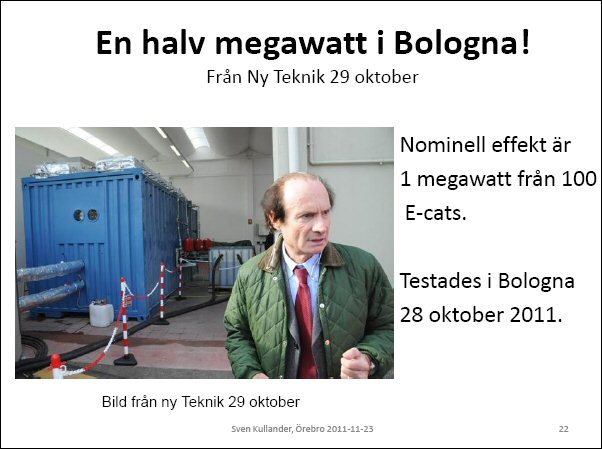
Kullander promotes Rossi’s E-Cat on Nov. 23, 2011, a public lecture at Orebro University
Problem: Essén said on Swedish public television that the Rossi device produced heat equivalent to 10 times the amount of electrical energy input. However, Essén never measured the heat output. He made a calculation based on his assumption that all water going into the system was vaporized. He assumed – or hoped – that Rossi was not feeding any unvaporized water down the drain.
Summary: Kullander and Essén never saw high rates of steam from Rossi’s device, did not perform direct measurements of the heat output and never had reliable data to support this extraordinary claim. Kullander and Essén failed to scientifically observe, analyze and report what they saw. Yet they reported to the public the Rossi claim as scientifically valid.
Result: As a result of their failure to follow customary scientific discipline and caution, Kullander and Essén have helped to promote a hoax, and possibly a fraud. If it is a fraud, it would not be the first time for Rossi.
Result: Kullander and Essén’s association with Rossi does not help promote legitimate science, the credibility of Uppsala University or LENR research. Their actions do not help to solve the world’s energy challenges but instead divert serious attention and support from legitimate LENR research.
Result: Kullander and Essén’s behavior sets a bad example for science students.
Result: Kullander and Essén have unintentionally promoted false hope to many people who seek better energy solutions. Many members of the public do not have the capacity to evaluate science and relied on the judgment of Kullander and Essén.
Editorial Comment: Kullander and Essén were up against a man with significantly different ethics and principles. They trusted Rossi. They allowed their subjectivity to guide them rather than their scientific discipline. By mid-2011, Kullander and Essén had enough information to know that their initial evaluation was weak and flawed. But rather than admit that to the public, and perhaps to themselves, they held tight to their initial conclusion without issuing a public retraction or even a qualification of their initial evaluation.
There is nothing wrong with Kullander and Essén’s admitting a mistake, even now. Rossi may someday deliver a device that produces energy as he claims. But that is independent from the fact that Kullander and Essén did not, and do not, have credible scientific support for their endorsement of Rossi’s device.
__________________________
[The writer would once more like to thank the many scientists, engineers and technical experts who helped him learn about steam and who contributed their detailed and precise technical analyses to the July 30, 2011, New Energy Times Report #3.]
Questions? Comments? Submit a Letter to the Editor.

